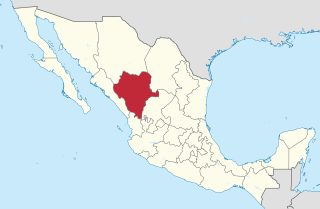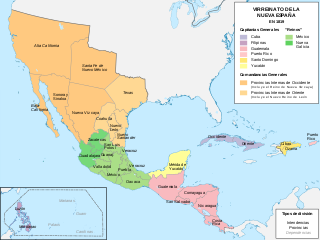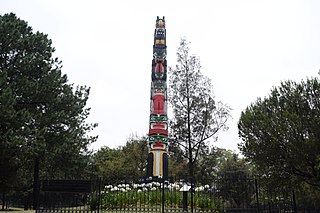
Coahuila, formally Coahuila de Zaragoza, officially the Free and Sovereign State of Coahuila de Zaragoza, is one of the 32 states of Mexico.

Durango, officially named Estado Libre y Soberano de Durango, is one of the 31 states which make up the 32 Federal Entities of Mexico, situated in the northwest of the country. With a population of 1,832,650, the 8th lowest of Mexico's states, Durango has Mexico's second-lowest population density, after Baja California Sur. The capital city, Victoria de Durango, is named after the first President of Mexico, Guadalupe Victoria.

Durango is the capital and largest city of the northern Mexican state of Durango and the seat of the Durango municipality. It has a population of 654,876 as of the 2015 census. The city's official name is Victoria de Durango, Victoria having been added in honor of the first president of Mexico, Guadalupe Victoria, who hailed from the state of Durango. The city is located in the Valley of Guadiana and sits at an altitude of 1,890 m (6,201 ft).

Durango is a state in Northwest Mexico that is divided into 39 municipalities. According to the 2020 Mexican Census, Durango is the 25th most populous state with 1,832,650 inhabitants, but the 4th largest by land area spanning 123,575.36 square kilometres (47,712.71 sq mi). Durango has a population density of 14.8/km2 (38.4/sq mi), making it Mexico's second-lowest dense state, after Baja California Sur.

Nueva Vizcaya was the first province in the north of New Spain to be explored and settled by the Spanish. It consisted mostly of the area which is today the states of Chihuahua and Durango and the southwest of Coahuila in Mexico.
Federal Highway 40, also called the Carretera Interoceánica, is a road beginning at Reynosa, Tamaulipas, just west of the Port of Brownsville, Texas, and ending at Fed. 15 in Villa Unión, Sinaloa, near Mazatlán and the Pacific coast. It is called Interoceanic as, once finished, the cities of Matamoros, Tamaulipas, on the Gulf of Mexico and Mazatlán on the Pacific Ocean will be linked.

Axtel S.A.B. de C.V., known as Axtel, is a Mexican telecommunications company headquartered in San Pedro, near Monterrey. It offers telephone, internet, and television services through FTTH in 45 cities of Mexico as well as IT Services. It is the second largest landline telephone service provider and a relevant virtual private network operator.
El Salto is a town and seat of the municipality of Pueblo Nuevo in the southwestern part of the Mexican state of Durango. As of 2015, the town had a total population of 24,241, Situated on a pine-forested plateau about 2,580 meters above sea level in the Sierra Madre mountain range, the town is home to a large lumber industry. It also has a military base. The surrounding municipality has a population of 50,417 and an area of 6,178.3 km².

According to the 2012 estimates, there were 100,000 Mennonites living in Mexico, the vast majority of them, or about 90,000 are established in the state of Chihuahua, 6,500 were living in Durango, with the rest living in small colonies in the states of Campeche, Tamaulipas, Zacatecas, San Luis Potosí and Quintana Roo.

Canatlán is one of the 39 municipalities of Durango, in northwestern Mexico. The municipal seat lies at Ciudad Canatlán. The municipality covers an area of 468643.1 km2.
Nuevo Ideal is one of the 39 municipalities of Durango, in north-western Mexico. The municipal seat lies at Nuevo Ideal.

Pueblo Nuevo is one of the 39 municipalities of Durango, in northwestern Mexico. The municipal seat lies at El Salto. The municipality covers an area of 6178.3 km2.

Santiago Papasquiaro is one of the 39 municipalities of Durango, in north-western Mexico. The municipal seat lies at Santiago Papasquiaro. The municipality covers an area of 7,238.4 km². Santiago Papasquiaro municipality is at an average height of 1,730 m (5,675 ft) over the sea level. The municipality lies east of Sierra Madre Occidental Mountain Range. It neighbors with other municipalities: Canelas and Tepehuanes municipalities at the north; San Dimas and Otáez, south; Nuevo Ideal to the east, Tamazula to the west and El Oro located northeast.

Nombre de Dios is a city and seat of the municipality of Nombre de Dios, established as Pueblo Mágico on October 11, 2018, in the state of Durango, north-western Mexico. As of 2015, the town of Nombre de Dios had a population of 5,302.
The 2011 Durango massacres were a series of mass murders that occurred in 2011. According to El Universal and Yahoo! News, at least 340 bodies have been found in mass graves around the city of Durango as of February 2012; These mass graves are the first of their kind in the state of Durango and third of their kind in Mexico. These mass graves had more bodies than the 2011 Tamaulipas massacre of 189 bus passengers. Since April 2011, there have been seven mass graves found around Durango. One of these mass graves was found in a vacant auto repair lot in Durango with 89 bodies. One of the bodies identified was Alfonso Peña, the former mayor of Tepehuanes Municipality, Durango.

Televisa Regional is a unit of Grupo Televisa which owns and operates television stations across Mexico. The stations rebroadcast programming from its subsidiary TelevisaUnivision's other networks, and they engage in the local production of newscasts and other programs. Televisa Regional stations all have their own distinct branding, except for those that are Nu9ve affiliates and brand as "Nu9ve <city/state name>".

Guillermo Ceniceros is a Mexican painter and muralist, best known for his mural work in Mexico City, as well as his figurative easel work. He began his mural painting career as an assistant to mural painters such as Federico Cantú, Luis Covarrubias and then David Alfaro Siqueiros who was a mentor and a key influence. Ceniceros is the most notable of Siqueiros' assistants. While he has experimented with abstract expression, his easel work mostly classifies as figurativism and is influenced by the geometrical construct of Mexican muralism. He has had over 300 individual and collective exhibitions in Mexico and the International stage. His work has been recognized by the Mexican Ministry of Culture and several of its institutions. He has painted over 20 large scale Mural Paintings with some of the most notable being the large scale work for the Legislative Palace of San Lazaro as well as his murals in the Metro Subway System. He is a member of the Salón de la Plástica Mexicana. In 1995, the State of Durango, Ceniceros' native state, opened to the public the Guillermo Ceniceros Art Museum within the oversight of the Ministry of Culture. Ceniceros has been reviewed by notable critics such as Berta Taracena, Raquel Tibol, Alaide Foppa, Graciela Kartofel, José Angel Leyva and Eduardo Blackaller among others. There are several publications about his work including a vast review of his art life endeavors developed by the Ministries of Culture of Durango and Nuevo León. He is married to the artist Esther González and lives in his studio house in the Colonia Roma of Mexico City.

Canadian Mexicans are Mexican citizens who have Canadian ancestry or are immigrants from Canada.
Federal Highway 40D is the designation for toll highways paralleling Mexican Federal Highway 40. Highway 40D connects Mazatlán, Sinaloa to Reynosa, Tamaulipas. It forms most of the highway corridor between Mazatlán and Matamoros, Tamaulipas, one of 14 major highway corridors in the country.














